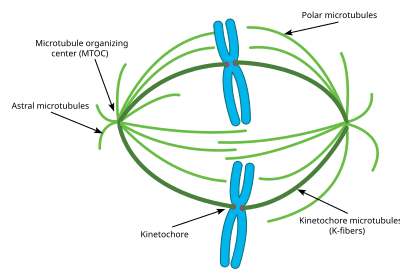
An aster is a cellular structure shaped like a star, consisting of a centrosome and its associated microtubules during the early stages of mitosis in an animal cell.[1]: 221 Asters do not form during mitosis in plants. Astral rays, composed of microtubules, radiate from the centrosphere and look like a cloud. Astral rays are one variant of microtubule which comes out of the centrosome; others include kinetochore microtubules and polar microtubules.
During mitosis, there are five stages of cell division: Prophase, Prometaphase, Metaphase, Anaphase, and Telophase. During prophase, two aster-covered centrosomes migrate to opposite sides of the nucleus in preparation of mitotic spindle formation. During prometaphase there is fragmentation of the nuclear envelope and formation of the mitotic spindles. During metaphase, the kinetochore microtubules extending from each centrosome connect to the centromeres of the chromosomes. Next, during anaphase, the kinetochore microtubules pull the sister chromatids apart into individual chromosomes and pull them towards the centrosomes, located at opposite ends of the cell. This allows the cell to divide properly with each daughter cell containing full replicas of chromosomes. In some cells, the orientation of the asters determines the plane of division upon which the cell will divide.[2]
- ^ Campbell NA, Reece JB (2005). Biology (7th ed.). San Francisco, CA: Benjamin Cummings. ISBN 0-8053-7171-0.
- ^ Lodish HF, Darnell DE (2008). Molecular Cell Biology (6th ed.). New York: W. H. Freeman and Company. pp. 782–783. ISBN 978-0-7167-7601-7.